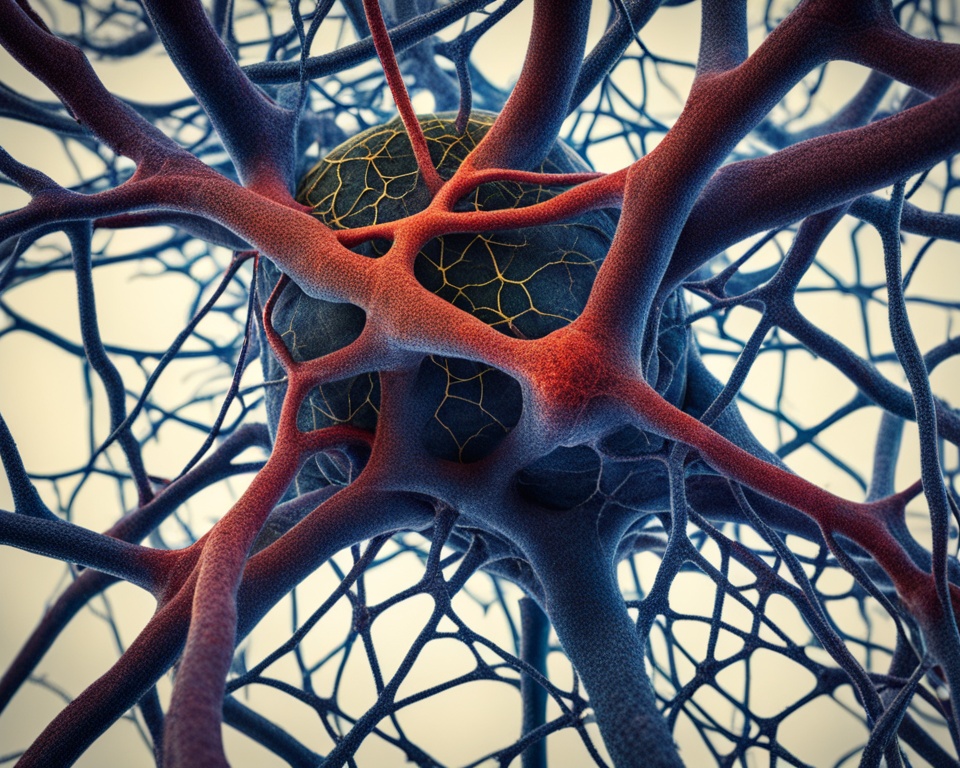
Mixed Anxiety and Depressive Disorder: Overview
Mental health issues often mix together in complex ways. This makes them hard to diagnose and treat. Mixed anxiety and depressive disorder is one such issue. It affects people of all ages and backgrounds. This guide will explain what this disorder is, how common it is, its effects, and the ways to treat it.
This disorder combines anxiety and depression symptoms at the same time. It’s different from other mental health problems where only one symptom is main. People with this disorder feel worried, restless, and sad all the time. These feelings can really hurt their daily life and happiness.
Read interesting things at : revolutionbookscamb
Key Takeaways
- Mixed anxiety and depressive disorder is a mental health condition characterized by a combination of anxiety and depressive symptoms.
- This disorder is relatively common, affecting individuals across age groups and demographics.
- The symptoms of mixed anxiety and depressive disorder can have a significant impact on an individual’s daily life and overall functioning.
- Effective treatment approaches often involve a combination of psychotherapy and medication management.
- Addressing the challenges and barriers to treatment, such as stigma and misconceptions, is crucial for improving outcomes for individuals with this disorder.
What is Mixed Anxiety and Depressive Disorder?
Mixed anxiety and depressive disorder is a mental health issue. It happens when someone has both ongoing anxiety and depression at the same time. This makes it hard for people to feel good and do everyday tasks.
People with this condition often feel worried, restless, and tense. They also feel sad, have low mood, and lose interest in things they used to like. This mix of feelings makes it tough for them to handle their symptoms and live a good life.
It’s important to understand mixed anxiety and depressive disorder. It’s a complex issue that challenges both the person and their doctors. By recognizing its unique nature, we can find better ways to help those affected.
“Mixed anxiety and depressive disorder is a complex mental health condition that requires a comprehensive and empathetic approach to support those affected.”
Symptoms of Mixed Anxiety and Depressive Disorder
Mixed anxiety and depressive disorder is a complex mental health issue. It combines both anxiety and depressive symptoms. It’s key for people to know these symptoms to get help.
Anxiety Symptoms
People with this disorder often worry a lot and feel restless. They might get easily irritated and find it hard to focus. They could also have physical issues like muscle tension, sweating, and a fast heartbeat.
Depressive Symptoms
Those with this disorder also have depressive symptoms. They might feel sad, hopeless, and not motivated. Their sleep, appetite, and energy could change. They might lose interest in things they used to enjoy.
This mix of symptoms can make life hard and cause a lot of distress. It’s important for those feeling this way to get help. They need to talk to professionals about their mixed anxiety and depressive disorder.
| Anxiety Symptoms | Depressive Symptoms |
|---|---|
|
|
These symptoms together can cause a lot of psychological distress. It’s crucial for those with anxiety symptoms and depressive symptoms to get help. They need to talk to professionals about their issues.
Prevalence and Risk Factors
Mixed anxiety and depressive disorder affects many people. It’s a complex mood disorder. The condition’s prevalence ranges from about 2% to 12% in the general population. But, many cases might not be diagnosed or recognized correctly.
Some groups face a higher risk of getting this disorder. Mood disorders like this are more common in women than men. Also, having a family history of mental health issues raises the risk. This suggests there might be a genetic link.
| Risk Factor | Description |
|---|---|
| Gender | Women are more likely to have mixed anxiety and depressive disorder than men. |
| Family History | People with a family history of mental health issues, like mood disorders, face a greater risk. |
| Traumatic Life Events | Going through tough life events or trauma can make getting this comorbid condition more likely. |
| Chronic Medical Conditions | Having ongoing health issues, such as chronic pain or neurological disorders, can also increase the risk. |
The risk factors for mixed anxiety and depressive disorder often overlap and interact. Knowing about these factors helps in spotting the condition early. It also aids in finding the right treatment and managing it better.
Impact on Daily Life and Functioning
Living with mixed anxiety and depressive disorder changes daily life a lot. It makes daily tasks hard and affects relationships. This mental health issue brings many challenges that disrupt daily life and social connections.
Personal and Social Consequences
People with mixed anxiety and depressive disorder find it tough in their personal and social lives. Symptoms like constant worry, feeling down, and lacking motivation make it hard to keep up with family, friends, and work.
This disorder also affects work or school performance. It can lead to less focus, less work done, and missing work. These issues can hurt career growth.
It’s not just work. Mixed anxiety and depressive disorder also make it hard to enjoy free time, go to social events, and do everyday tasks. Feeling anxious and depressed takes away the joy from activities that were once fun.
| Personal Consequences | Social Consequences |
|---|---|
|
|
Mixed anxiety and depressive disorder deeply affects daily life and functioning. It leads to big personal and social issues. Getting the right mental health help and using good coping methods is key for those with this disorder. It helps them improve their life and find happiness again.
Comorbidities and Related Conditions
Understanding mixed anxiety and depressive disorder means looking at how it connects with other mental health issues. People with this disorder often face more mental health problems at the same time. These are called comorbid conditions.
One common issue is substance abuse. Studies show that those with mixed anxiety and depressive disorder are more likely to develop substance use disorders. This can lead to a cycle where using substances might help with symptoms but makes mental health worse over time.
Chronic pain is another condition often linked with mixed anxiety and depressive disorder. Research finds a strong connection between these disorders and chronic pain types like fibromyalgia, migraines, and back pain. Each condition can affect the other, making it hard to break the cycle.
People with mixed anxiety and depressive disorder are also more likely to get other mood disorders. This includes major depressive disorder or generalized anxiety disorder. These conditions make treating mental health more complex, needing a detailed plan to meet each person’s needs.
Knowing about comorbidities and related conditions with mixed anxiety and depressive disorder is key to good care. By seeing how these issues are connected, doctors can create better treatments and support. This helps improve mental health and quality of life for everyone involved.
Causes and Contributing Factors
Mixed anxiety and depressive disorder comes from a mix of biological, environmental, and psychological factors. Knowing what causes it helps in treating and managing it.
Biological Factors
Genetics and brain chemistry are big parts of the biological causes. If your family has a history of mental health issues, you might be more likely to get it. Also, problems with brain chemicals like serotonin and norepinephrine can lead to feeling anxious and depressed at the same time.
Environmental and Psychological Factors
Hard times in life, like losing someone close or dealing with money problems, can also cause mixed anxiety and depression. People who have gone through tough times might be more likely to feel this way. Thinking negatively and using bad ways to cope can also make it worse.
| Biological Factors | Environmental Factors | Psychological Factors |
|---|---|---|
| Genetic predisposition | Stressful life events | Negative thought patterns |
| Neurochemical imbalances | Traumatic experiences | Maladaptive coping strategies |
| Family history of mental health disorders | Chronic stress | Difficulty regulating emotions |
Understanding these factors helps doctors know what causes mixed anxiety and depression. They can then make treatment plans that fit each person’s needs.

Diagnosis and Assessment
Getting a correct diagnosis of mixed anxiety and depressive disorder needs a detailed check-up by healthcare experts. This condition often shows both anxiety and depression symptoms. So, a full assessment is key.
The steps for diagnosis include:
- Clinical interview: A mental health expert, like a psychiatrist or psychologist, will talk with you. They want to know about your symptoms, health history, and mental health.
- Symptom evaluation: The doctor will look at how bad and how long your anxiety and depression symptoms have been there. They check if they fit the criteria for mixed anxiety and depressive disorder.
- Psychological assessments: Tests and scales might be used to measure your symptoms and how they affect your daily life.
- Physical examination: A full check-up, including lab tests, might be done to rule out any health issues that could be causing your symptoms.
- Differential diagnosis: The doctor will look at other mental health conditions to make sure they diagnose you correctly and give the right treatment.
Getting a correct diagnosis of mixed anxiety and depressive disorder is very important for treatment. A detailed check-up helps people get the right care and support. This can help them manage their symptoms and feel better overall.
“Diagnosing mixed anxiety and depressive disorder requires a delicate balance of clinical expertise and careful evaluation. It is a complex condition that requires a comprehensive approach to ensure the best possible outcomes for patients.”
Treatment Approaches
Healthcare experts often suggest a mix of psychotherapy and pharmacotherapy for managing mixed anxiety and depressive disorder. These methods can help ease symptoms and boost well-being.
Psychotherapy
Cognitive-behavioral therapy (CBT) is a key psychotherapy for this condition. It helps people spot and change negative thoughts, learn coping skills, and beat their symptoms. CBT tackles the mental and behavioral parts of the disorder, leading to better mood and less anxiety.
Other therapies like interpersonal therapy and mindfulness-based approaches are also effective. They work on improving relationships, managing emotions, and building self-awareness and acceptance.
Pharmacotherapy
Medications are a big part of treating mixed anxiety and depressive disorder. Antidepressants, such as SSRIs and SNRIs, are commonly used to tackle anxiety and depression. These drugs balance neurotransmitters in the brain, easing symptoms and enhancing function.
Healthcare providers might also prescribe anti-anxiety drugs or mood stabilizers for extra relief. It’s key to work closely with a doctor to find the right medication and watch for side effects.
Combining psychotherapy and pharmacotherapy offers a well-rounded treatment plan. It addresses both the mental and biological sides of the condition.
Lifestyle and Self-Management Strategies
Managing mixed anxiety and depressive disorder needs a full approach, not just medicine. Adding lifestyle and self-management steps can really help improve well-being and aid in recovery. Here are some easy steps to help you manage your mental health better.
Stress Management Techniques
Too much stress can make mixed anxiety and depressive disorder worse. Using meditation, deep breathing, and progressive muscle relaxation can help you handle stress better. These methods can bring you peace and calm.
Maintaining a Healthy Routine
Having a daily routine can give you a sense of order and stability. This is great for those with mixed anxiety and depressive disorder. It means getting enough sleep, eating well, and staying active. Also, make time for hobbies and fun activities.
Seeking Social Support
Having a strong support network is key to managing mixed anxiety and depressive disorder. Connecting with family, friends, support groups, or mental health professionals can make you feel supported. They can offer understanding and help you deal with the challenges you face.
| Lifestyle Strategy | Benefits |
|---|---|
| Stress Management | Reduces the impact of stress on mental health |
| Maintaining a Healthy Routine | Provides structure and stability, supporting overall well-being |
| Seeking Social Support | Fosters a sense of connection and understanding, aiding in the recovery process |
By using these lifestyle and self-management strategies, people with mixed anxiety and depressive disorder can play a big part in their mental health care. This can lead to a better life overall.

“Empowering individuals with mixed anxiety and depressive disorder to adopt healthy lifestyle habits can be a powerful complement to clinical interventions, leading to more holistic and sustainable improvements in mental well-being.”
Challenges and Barriers to Treatment
People with mixed anxiety and depressive disorder often find it hard to get mental health treatment. A big hurdle is the stigma around mental health in our society.
Stigma and wrong ideas stop people from getting help. They might feel ashamed, scared, or not understood. Many think mental health issues show weakness, not a real medical problem needing help.
Stigma and Misconceptions
- Lack of public understanding about the realities of mixed anxiety and depressive disorder
- Negative stereotypes and judgmental attitudes towards individuals with mental health issues
- Concerns about confidentiality and the fear of being labeled or discriminated against
- Lack of open discussion and education around the importance of seeking mental health treatment
These deep-seated attitudes make it hard for people with mixed anxiety and depressive disorder to get the care they need. We must work together to spread awareness, fight wrong ideas, and support a kinder, more open view of mental health.
“The greatest weapon against stigma is education.”
— Norman Sartorius, psychiatrist and former president of the World Psychiatric Association
Support Resources and Professional Help
Facing the challenges of mixed anxiety and depressive disorder can feel overwhelming. But, you’re not alone. There are many support resources and professional help options available to help you on your path to better mental health.
One key step is to get advice from mental health experts. This could be psychologists, psychiatrists, or therapists who focus on mixed anxiety and depressive disorder. They can offer personalized help, including assessments and treatments that fit your needs.
Support groups are also a great resource. They let you connect with people who understand what you’re going through. You can find both local and online groups that provide a safe space to share and learn from each other.
Self-help resources, like books, apps, or online courses, can also be very helpful. They can give you new ways to deal with your symptoms and improve your mental health.
You don’t have to go through this alone. Talk to your doctor, community services, or people you trust for help. With the right support and treatment, you can manage your mixed anxiety and depressive disorder and improve your life.
| Support Resource | Description |
|---|---|
| Therapy | Seek guidance from licensed therapists, psychologists, or counselors who specialize in mixed anxiety and depressive disorder treatment. |
| Support Groups | Connect with others who share similar experiences, both in-person and online, for a sense of community and shared coping strategies. |
| Self-Help Resources | Explore educational materials, mobile apps, and online programs to learn skills and techniques for managing mixed anxiety and depressive disorder. |
| Hotlines and Crisis Support | Access immediate help and support during times of crisis or acute distress related to mixed anxiety and depressive disorder. |
Conclusion
Mixed anxiety and depressive disorder is a complex mental health issue. We’ve looked at its symptoms, how common it is, and its effects on life. We also talked about the different ways to treat it.
Dealing with this disorder is tough because it can make everyday tasks hard. But, with more awareness, professional help, and good coping skills, people can get better. They can improve their well-being and life quality.
It’s important to keep funding research and teaching about mental health. We need to work together to help those with mixed anxiety and depression. By doing so, we can create a caring society that supports everyone’s mental health. Together, we can make a difference and help those facing this challenge.










Leave a Reply